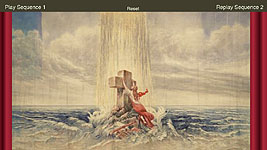The Grand Allegorical Transformation Scene
To produce this effect, the Harmount Company carried 3 Armbuster drops:




Clicking on the Sequence 1 button, you'll see a sea of troubles give way to clouds and angels, leaving the woman in the picture safely with the cross -- to me this makes the most sense, allegorically. In Sequence 2, the clouds that surround the woman lift away to leave her clinging to the rock of the cross -- to me this makes the strongest impact, visually. The band would have played appropriate music throughout the scene, though since the script doesn't specify a song we haven't given the sequences a sound track.
Other sequences are possible, of course, and the 3 drops were only part of the larger effect. In a 1915 LETTER describing his show to theater managers, C. B. Harmount refers to an "electrical" effect, and we know from the company's 1915 PUBLICITY BROCHURE that Little Eva also figured in the "transformation." In the contemporaneous film versions of the play, for example, she typically wears wings and floats suspended by wires over the dying Tom -- it's possible that the actress playing Eva was lowered behind the drop to appear as an angel in the smaller hole in front of the image of the woman. We haven't tried to reproduce either of these elements digitally, with the help of your imagination as well as electronic technology, you can get several ideas of how the "transformation scene" may have been worked.
One other point to note concerns race. This scene begins after Tom dies at the front of the stage, and George Shelby asks God to witness his death. But as the scene unfolds, all signs of blackness are erased. The woman at the cross, the angels in the clouds, even the clouds -- all are white. So audiences witness the "transformation" of a black man's death into a white woman's redemption.

